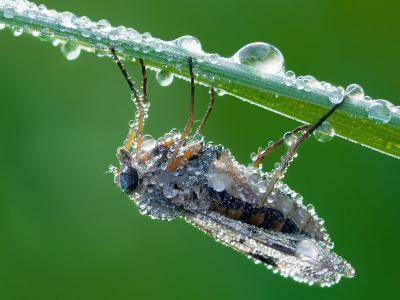Jumping droplets clean wings
A drop or three of dew is all a cicada needs to keep its wings fresh and clean during its four- to six-week life.

Researchers at James Cook University in Townsville and Duke University in North Carolina in the US have shown that water-repellant (superhydrophobic) surfaces, such as cicada wings, can cause dew drops to ‘jump’ by themselves and carry away contaminants.
The team, led by Chuan-Hua Chen at Duke University’s Pratt School of Engineering, demonstrated that tiny particles such as pollen can be removed from cicada wings. When growing dew drops coalesce together, the merged drop automatically jumps off the surface powered entirely by the surface energy initially stored in the dew drops.
There are more than 200 cicada species in Australia. Typically a few inches long, the most common species of this flying insect emerge on a yearly basis; however, the periodical cicadas of North America can spend 13 or 17 years underground.
Their wings are characterised by rows and rows of tiny bumps or domes of various heights and widths. When a water droplet lands on this type of surface, it only touches the points of the bumps, creating pockets of air underneath which keep the droplet aloft.
“Most cicadas are unable to clean their own wings because of their short appendages,” said Gregory Watson from James Cook University. “These insects commonly live in areas where there is little rain over an extended period of time. However, the areas are humid, which provides the tiny dew droplets needed to ‘jump clean’ their wings.”
The researchers captured the jumping water droplets and the associated self-cleaning processes on a cicada wing using a specially designed high-speed video imaging system.
“The ability of water-repellant surfaces to self-clean has conventionally been attributed to rain droplets picking up dirt particles,” Chen said. “For this conventional wisdom to work, rainfall must be present and the orientation has to be favourable for gravity to effectively remove the rain droplets. These limits severely restrict the practical use of self-cleaning superhydrophobic surfaces.
“We have found, however, that the self-propelled jumping motion of the dew drops is very effective in dislodging contaminating particles, regardless of the orientation,” Chen said.
These new insights will help guide the development of surfaces that are not reliant on external forces but are truly self-cleaning.
“These findings point to an alternative route to achieve self-cleaning, which is fundamentally different from the conventional wisdom involving rolling or colliding droplets on a superhydrophobic surface,” Chen said. “Self-cleaning surfaces using the jumping-drop mechanism can work at any orientation, which is a huge advantage for applications with unfavourable orientations with respect to gravity, such as mobile electronics and building roofs.”
The research was published online in Proceedings of the National Academy of Sciences.
Babies of stressed mothers likely to get their teeth earlier
Maternal stress during pregnancy can speed up the timing of teeth eruption, which may be an early...
Customised immune cells used to fight brain cancer
Researchers have developed CAR-T cells — ie, genetically modified immune cells manufactured...
Elevated blood protein levels predict mortality
Proteins that play key roles in the development of diseases such as cancer and inflammation may...



